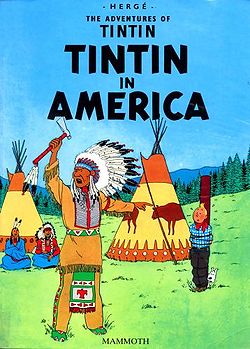As I vowed to do so a few months ago, 2011 is the year that I’m going to sit down and read… well, if not all of the Tintin albums, most of them. (The jury is still out on if I’m going to tackle the two early/problematic volumes of Tintin in the Land of the Soviets and Tintin in the Congo, and the never-completed Tintin and Alph-Art. But the other 21 are all on the to-read list.)
While I don’t see myself writing full reviews of them, I did think it would be fun to write down somewhere my impressions of the books as I make my way through them.
 So, Tintin in America. First published in 1932 as a black and white edition, redrawn (and shortened) in 1945, and then slightly edited in 1973 when published in the United States. It’s…
So, Tintin in America. First published in 1932 as a black and white edition, redrawn (and shortened) in 1945, and then slightly edited in 1973 when published in the United States. It’s…
…well, it’s a good thing Tintin has such a high pedigree or I doubt I’d be planning on reading Cigars of the Pharaoh next. It’s not actively bad, but I don’t think I’d go out of my way to tell people to read it either. Tintin taking on gangster-era Chicago sounds like a potentially fun story, but there’s so much of it that just strikes me as slightly inept. Tintin seems to be someone who benefits by good luck more than smarts half of the time (the number of near-death experiences inadvertently stopped by a third party is rather high), and it’s got such a rushed conclusion that I wonder if when the book was shortened to just 62 pages if Herge did so by throwing out everything beyond a certain point.
I found myself unsure if Tintin’s dog Snowy is supposed to actually talk or if we’re just hearing his thought processes. I’d assumed it was the latter for most of the book, but at one point he tells Tintin where he’s been for the previous few pages, and Tintin seems to understand him. Odd. And Snowy is also slightly irritating.
The depiction of the Indians is rather painful to read. It’s a big pile of stereotypes, and to top it off they’re either stupid or inept the entire time. “Make it stop,” was the thought I had during that entire sequence. Of course, when it does, it’s the one time the tone shifts with them as the Indians are abused by the US Government in order to perform a land grab. After bad slapstick and jokes centering around them up until that moment, the tonal shift is rather startling.
I did, however, like Herge’s beautiful and clean art. It’s the high point of the book, and for that alone I’m glad to have finally dipped into the Tintin library. I’ll admit I had some second thoughts on if I’m going to continue reading the books in order (especially after reading an announcement today about Fantagraphics publishing the entire Carl Barks “Ducks” library, but doing so slightly out of order in order to jump into some of the best books and storylines first), but for now I’m planning on pushing on.
Hmm. I suspect more write-ups down the line won’t be quite so long. Anyway, I’ll try and read Cigars of the Pharaoh later this month!